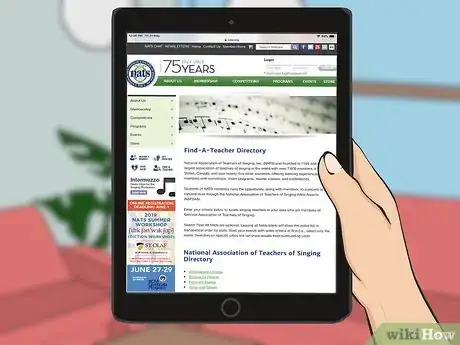This article was co-authored by Amy Chapman, MA. Amy Chapman MA, CCC-SLP is a vocal therapist and singing voice specialist. Amy is a licensed and board certified speech & language pathologist who has dedicated her career to helping professionals improve and optimize their voice. Amy has lectured on voice optimization, speech, vocal health, and voice rehabilitation at universities across California, including UCLA, USC, Chapman University, Cal Poly Pomona, CSUF, CSULA. Amy is trained in Lee Silverman Voice Therapy, Estill, LMRVT, and is a part of the American Speech and Hearing Association.
There are 13 references cited in this article, which can be found at the bottom of the page.
This article has been viewed 72,216 times.
Singing in tune, or with correct pitch, does not come naturally to everyone. However, with enough practice, most people can eventually learn how to do it. To sing in tune, it is essential to know your vocal range and practice controlling your voice and breathing. If you spend time getting to know the strengths and limitations of your own unique voice, you'll be on your way to singing your favorite songs in tune!
Steps
Analyzing Your Voice to Find Your Range
-
1Test yourself for tone deafness before you begin training. True tone deafness is a rare biological condition called amusia. Most people are not tone deaf, they just need to train their ears to recognize pitch. To determine whether or not you're tone deaf, you can take a tone deafness test on one of several websites and apps, or you can visit an audiologist to be professionally evaluated.[1]
- Being tone deaf doesn’t mean you will never be able to sing–it just means that you will have to seek out special training from an audiologist or vocal coach to identify pitches through vibrations.
- Check out one of these sites to test yourself: http://tonedeaftest.com/ or https://beta.themusiclab.org/quizzes/td.
-
2Record yourself singing and compare it to other singers. To begin to identify your own pitch and range, record yourself singing a song that you know well and play it back, noting where you think you sound very good and where you think you need to improve. Doing this will help you start to notice the different notes you can reach and those you struggle with.[2]
- Listen to yourself over and over again and also listen to the song as sung by a professional. The more you listen, the more your ear will recognize the differences.
- Print out the sheet music or the lyrics and circle or highlight the areas you think you need to work on. This will help you keep track of your problem areas and your progress.
Advertisement -
3Sing along with an instrument to precisely define your vocal range. Use a piano or an app that generates notes to help you identify your vocal range. Sing back the sounds you hear to determine how low and how high you can go before your voice either strains or cracks. Basically, your range extends from the lowest note you can comfortably sing to the highest.[3]
- It's important to know your range because if you try to sing notes outside your comfortable range, they are more likely to sound pitchy and not pleasing to the ear.
- There are several apps available, such as PitchPro, Voice Tuner, and Harmonize that can help you find your range by playing sounds for you to emulate.
-
4Consult a trained musician for help finding your range. If you are not sure of your vocal range after trying to discover it yourself, seek out an expert to help you figure it out. Ask a friend who is a trained singer or find a local, reputable vocal coach to get feedback on your vocal abilities.
- If you are in the U.S., you can find registered vocal coaches from the online directory of the National Association of Teachers of Singing. If you are outside the U.S., look for a similar type of organization in your country.[4]
Learning and Practicing Basic Singing Skills
-
1Stretch to open up your airways for easier breathing. To stretch before singing, first you want to bend over until your hands almost reach the floor. While in that position, inhale deeply for about 3 seconds. Then, exhale slowly. Repeat the breaths 2-3 times to elongate your airways and prepare your body for singing longer notes.[5]
- Have a chair or something nearby to hold on to in case you get dizzy doing this stretch.
-
2Stand with proper posture to open your airways and make deep breaths possible. To sing in tune, you have to be able to hold your breath long enough to carry the note. To stand so that you can maximize your breaths, roll your shoulders back and down, make sure your chin is parallel to the floor, and put your hands relaxed at your sides.[6]
- Standing with very straight posture can feel awkward if you are not used to it, but the more you practice, the more natural it will feel.
-
3Practice belly breathing to help you hold notes longer. Belly breathing, also called diaphragmatic breathing, is essential to master and get comfortable doing if you want to be a singer.[7] To breathe from your belly, relax your chest and shoulders and focus on pushing out your belly as you take a deep breath in. You should see your belly expand as you do it. Then, exhale deeply, concentrating on contracting your stomach muscles and bringing your belly back to its resting state.[8]
- The best way to get comfortable belly breathing is to practice it often so that it becomes natural for you to do.
- Watch yourself practice belly breathing in front of a mirror. Make sure you can clearly see your belly expanding and contracting and not your chest rising and falling.
-
4Hum scales to improve your hearing and control. Warm up your voice and practice hitting the correct pitch by humming notes in your range from lower notes to higher ones. Use online videos or audio recordings to hear the various scales and record yourself humming back the sounds you hear. Compare the recordings of yourself with the originals, identify where you don't sound the same, and keep making new recordings until you can’t hear a difference between the two.[9]
- Humming is a great way to prepare for in-tune singing because it warms up your voice without putting stress on your vocal chords.
-
5Train your voice to sing certain notes using solfege syllables. You have likely heard of solfege syllables before. They are notes usually sung in scales to the sounds of Do-Re-Mi-Fa-Sol-La-Ti-Do. Practice making the different sounds of the scales using the solfege syllables in order.[10] Then, change it up and move around the scale to improve your hearing and pitch.[11]
- Solfege syllables are great for training your voice because they are simple one-syllable sounds that flow easily from one to the next. Children's music teachers rely on teaching sounds with solfege syllables because they provide an easy way for anyone to associate the short sounds with the musical notes.
-
6Use digital tools to fine tune your voice. There are a lot of digital tools available that will tell you the notes that you are singing so you can practice getting the right ones. You can get a digital tuner from a music store or an online retailer, or there are numerous apps available for download on your phone or tablet. Practice control of your voice using the digital tools’ feedback to make adjustments.[12]
- Look for digital tuner apps like ClearTune or Tonal Energy.[13]
-
7Train with a vocal coach to get an outsider’s perspective. Even famous and highly-skilled singers work with vocal coaches to constantly improve their skills. Vocal coaches are trained to identify issues with your singing and teach you exercises that will help you improve. If you are able, working with a vocal coach is a great idea for learning to master singing in tune.
- In the U.S., check the database of the National Association of Teachers of Singing to find a register vocal coach near you. Or, ask around to musicians you know or stop in a local music shop to ask if they have lessons or can direct you somewhere that does.[14]
Singing Songs in Tune
-
1Apply your newly learned vocal control by mastering a song. Try to learn every note of a song and sing it perfectly to improve your control over your pitch. It’s best to record yourself with just a backing track that has the instrumental with no voice, but if you don’t have one available, you can sing along with the vocals on the original track.[15]
- Record and play back your song over and over, taking notes and making improvements every time. As you listen to yourself sing, write down the parts that you do very well and the parts that need improvement.
- You can find backing tracks by looking for karaoke versions of songs in online videos, in a music store, or from online retailers.
-
2Recognize and accept that some notes are outside your vocal range. The lengths of your vocal cords control your pitch. Shorter vocal cords produce higher-pitched sounds than longer vocal cords. There is nothing you can do to change the lengths and so some sounds will always be outside your ability to reach. Therefore, when choosing which songs to learn to sing, it's important to select those within your vocal range.[16]
- Children tend to sing in the same higher pitch because they have short vocal cords that have not yet fully developed. As people get older and their vocal chords change, their voices change as well.[17]
-
3Build a repertoire of songs you are comfortable singing. A singer’s repertoire usually consists of three songs that they can sing very well. Begin your repertoire by learning and completely mastering singing one song in tune.[18]
- Your repertoire should always be changing as you improve your skills. Trade out new songs with old songs, or increase the number of songs, as you feel comfortable and master the material.
-
4Challenge yourself with increasingly difficult songs. Push the limits of your voice and your ability to carry the notes by learning more difficult songs (that are, of course, within your range). Be diligent about adding new songs to your repertoire, continuously evaluating your performance, and making necessary tweaks to improve upon it.[19]
Expert Q&A
Did you know you can get expert answers for this article?
Unlock expert answers by supporting wikiHow
-
QuestionHow long does it take to learn to sing in tune?
 Amy Chapman, MAAmy Chapman MA, CCC-SLP is a vocal therapist and singing voice specialist. Amy is a licensed and board certified speech & language pathologist who has dedicated her career to helping professionals improve and optimize their voice. Amy has lectured on voice optimization, speech, vocal health, and voice rehabilitation at universities across California, including UCLA, USC, Chapman University, Cal Poly Pomona, CSUF, CSULA. Amy is trained in Lee Silverman Voice Therapy, Estill, LMRVT, and is a part of the American Speech and Hearing Association.
Amy Chapman, MAAmy Chapman MA, CCC-SLP is a vocal therapist and singing voice specialist. Amy is a licensed and board certified speech & language pathologist who has dedicated her career to helping professionals improve and optimize their voice. Amy has lectured on voice optimization, speech, vocal health, and voice rehabilitation at universities across California, including UCLA, USC, Chapman University, Cal Poly Pomona, CSUF, CSULA. Amy is trained in Lee Silverman Voice Therapy, Estill, LMRVT, and is a part of the American Speech and Hearing Association.
Singing Coach
-
QuestionWill I ever be able to sing, even though I don't have singing in my genes?
 Community AnswerJust because no one in your family can sing, doesn't mean you can't.
Community AnswerJust because no one in your family can sing, doesn't mean you can't. -
QuestionSometimes voice cracks! How can I make it stop?
 Community AnswerDrink warm water with honey and a little lemon juice once a day.
Community AnswerDrink warm water with honey and a little lemon juice once a day.
References
- ↑ https://www.musical-u.com/learn/how-to-learn-to-sing-in-tune/
- ↑ https://www.musicindustryhowto.com/learn-how-to-sing-in-tune-naturally-for-beginners/#2_How_To_Sing_In_Tune_For_Beginners_Learn_The_Correct_Breathing_Techniques
- ↑ https://www.musicnotes.com/now/tips/determine-vocal-range/
- ↑ https://www.nats.org/cgi/page.cgi/find_teacher.html
- ↑ https://www.youtube.com/watch?v=PJzflvDTWno&feature=youtu.be&t=94
- ↑ http://cmed.faculty.ku.edu/gummposture/posture.html
- ↑ http://www.howtosingsmarter.com/breathing-exercises-for-singing/
- ↑ https://www.youtube.com/watch?v=PJzflvDTWno&feature=youtu.be&t=50
- ↑ https://www.youtube.com/watch?v=AgimvuugWus&feature=youtu.be&t=20
- ↑ https://www.youtube.com/watch?v=5QgauSvYIyg&feature=youtu.be&t=32
- ↑ https://www.youtube.com/watch?v=5QgauSvYIyg&feature=youtu.be&t=67
- ↑ https://www.musical-u.com/learn/how-to-learn-to-sing-in-tune/
- ↑ https://bulletproofmusician.com/five-best-tuner-apps/
- ↑ https://www.nats.org/cgi/page.cgi/find_teacher.html
- ↑ https://www.musical-u.com/learn/how-to-learn-to-sing-in-tune/
- ↑ https://www.scientificamerican.com/article/singing-science-how-high-and-low-can-you-go/
- ↑ https://www.scientificamerican.com/article/singing-science-how-high-and-low-can-you-go/
- ↑ https://www.musical-u.com/learn/how-to-learn-to-sing-in-tune/
- ↑ https://www.musical-u.com/learn/how-to-learn-to-sing-in-tune/












































































